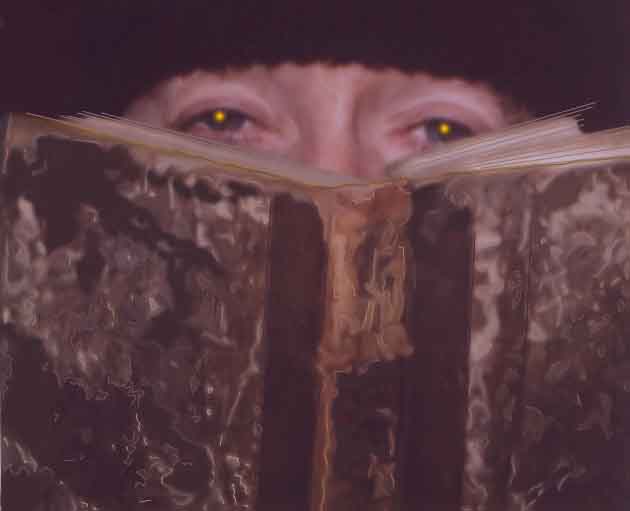









RICHARD BROWN
[First published in 1996 in Winnipeg's Border Crossings magazine as "Catch as Paint Can," Winter, 56-58. The October 28-December 8, 1995 exhibition was part of "The Manitoba Studio Series" of solo exhibitions curated by Shirley Madill for the Winnipeg Art Gallery.]
Paint is a material with light caught in it, something between sculpture and photo emulsion. On the evidence of this work, Richard Brown must believe, as I do, that paint deserves as much of a material presence in a painting as the image conveyed by it.
In this work Brown goops heavy paint through a stencil so that single images--for example: a snake, a faucet, a fighter aircraft, a step ladder, a wrench, a tree--settle on top of a painted grid work. The artist invents a new ideograph with each painting. But ideographs like Brown's cannot be read the way one reads Japanese, as if they were haiku made not of words, but of a few precisely-placed silhouettes in a tight painterly structure. The images straddle the grid lines as if they were pieces being played in a mysterious board game, symbols which are vague enough to let a viewer complete the conceptual picture. Imaginary problems can lead to imaginary solutions made from the cryptic clues these paintings provide (indeed, one of Brown's paintings is called "Domestic Clue."). The colour in much of the work is soothing, an aid to long looking. One is is tempted to return again and again to project more problems and solutions onto these works. That is how they yield their secrets, or, I should say, that is how these paintings yield a viewer's secrets.
I don't really mean "secrets." A Renaissance painting such as Georgione's The Tempest cannot be "figured out" today because we have lost the literary keys to what must have been an allegorical meaning made up of its mix and match motives; but with contemporary work like Brown's, the right allegorical key cannot solve the puzzle. That goes for much other contemporary painting and still more installation art. The inevitable hazard of this genre is, of course, its assumption--or demand-- that viewers play the game. One cannot insist on deciphering a work like a Richard Brown painting the way one deciphers code. Brown is not a maker of rebuses, but a maker of paintings.
What I have said about viewing Brown's work may seem trivial--are not all works of art approached with a view to their contemplative possibilities? I think not. Too much contemporary art makes its point in an overbearing, oversimplified way which discourages a second look.
"New Image" painters in the late seventies and early eighties used a technical means very similar to Brown's: the paint was applied generously, the images were very simply delineated or were silhouettes, and the sources of images were not, as in so much seventies painting, derived from photographs. What makes the revival of this ethos in the work of Richard Brown and other contemporary "silhouette painters" (such as Gerald Ferguson) is, perhaps, their having come to the style after, and not before, becoming skilled draftsmen and painters. Technical skill and care make (new) "new image" work much more convincing than (old) "new image" painting.
It is unfortunate that Richard Brown's paintings were reproduced in black and white in the Winnipeg Art Gallery's brochure: the richness of their colour is important.
The stone walls of the upper floor WAG lobby were inappropriate for this exhibition both because the busy surfaces of the stone interfered with one's field of vision as the the smaller paintings were viewed. In addition, the works were hung on wires no doubt because of the stone walls, making them feel as if they were not flush. To me it seems to be essential for the proper viewing of this sort of grid painting that it be hung flat on a surface.
The catalogue essay for this exhibition by Jennifer Woodbury is clearly written and helpful.

|
|